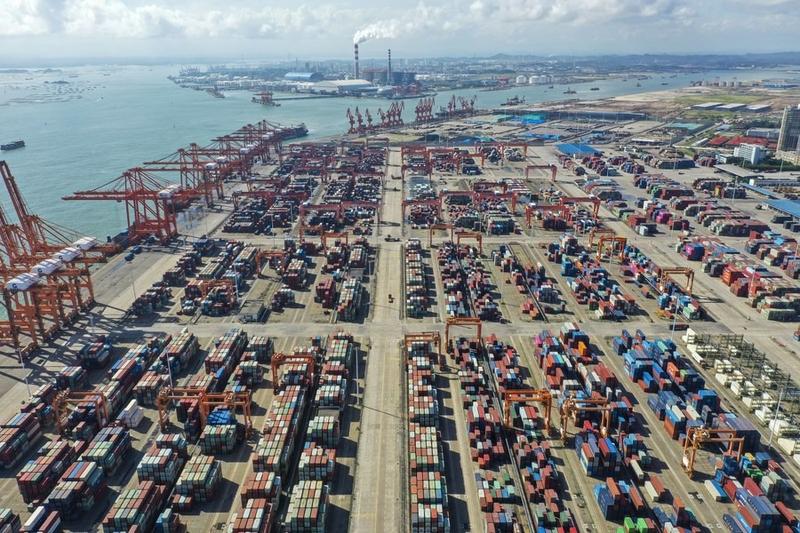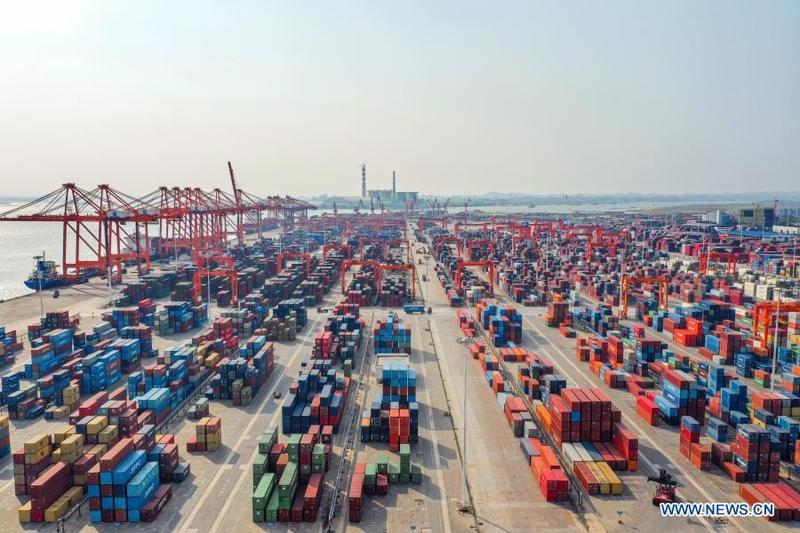 Aerial photo taken on Aug 27, 2022 shows the Qinzhou port near the estuary of Pinglu Canal, in Qinzhou City, south China's Guangxi Zhuang autonomous region. (PHOTO / XINHUA)
Aerial photo taken on Aug 27, 2022 shows the Qinzhou port near the estuary of Pinglu Canal, in Qinzhou City, south China's Guangxi Zhuang autonomous region. (PHOTO / XINHUA)
NANNING - Amid the heat of a summer morning, Huang Zhiyi, a 34-year-old container crane operator, hopped on an elevator to reach his workstation 50 meters above the ground and started the day of "heavy lifting". All around him, the usual bustling scene was in full swing, with cargo ships coming and going with their loads of freight.
Having worked as a crane operator for 11 years, Huang is a seasoned veteran at Qinzhou Port of Beibu Gulf Port, in south China's Guangxi Zhuang autonomous region.
"It takes more time to load or unload a container packed with cargo than an empty one", said Huang. "When there is an even split of full and empty containers, I can handle about 800 containers per day."
Official figures from China's Ministry of Transport show that in the first four months of this year, cargo throughput at China's ports rose 7.6 percent year-on-year to 5.28 billion tonnes, while that of containers reached 95.43 million TEU, a 4.8 percent increase year-on-year
However, these days he can only do about 500 per day, because most of the containers going through the port are fully loaded with export goods.
China's total imports and exports expanded 4.7 percent year-on-year to 16.77 trillion yuan (about $2.36 trillion) in the first five months of 2023, showing continued resilience amid sluggish external demand. Exports grew 8.1 percent year-on-year, while imports rose 0.5 percent during the period, the General Administration of Customs (GAC) said early this month.
ALSO READ: China submits papers for CPTPP accession
Lyu Daliang, an official with the GAC, said that China's foreign trade has been largely propped up by a continued rebound in the country's economy, and a series of policy measures has been rolled out to help business operators actively respond to the challenges brought by weakening external demand, while effectively seizing market opportunities.
As the recovery in foreign trade has picked up momentum, the number of shipping containers packed with goods heading overseas has grown considerably. The hustle and bustle at Qinzhou Port reflects the uptick in business at major ports across the country.
From January to May, the cargo throughput of Beibu Gulf Port, which consists of three individual ports situated at Guangxi's coastal cities of Beihai, Qinzhou and Fangchenggang, respectively, was 121 million tonnes, up almost 6 percent year on year. The container volume handled by the port amounted to 2.95 million twenty-foot equivalent unit (TEU), a 13.74 percent increase from the same period last year.
Official figures from China's Ministry of Transport show that in the first four months of this year, cargo throughput at China's ports rose 7.6 percent year-on-year to 5.28 billion tonnes, while that of containers reached 95.43 million TEU, a 4.8 percent increase year-on-year.
ALSO READ: Meeting lays out policies to boost recovery in China
"Port activity is a barometer of how a national economy is faring, and the ports and foreign trade are inextricably entwined," said Chen Yingming, executive vice- president of China Ports & Harbors Association. "It is clear that a sustained growth in the area will boost the volume of cargo handled by the ports."
 Aerial photo taken on May 27, 2020 shows a view of the container terminal of Beibu Gulf Port in south China's Guangxi Zhuang autonomous region. (PHOTO / XINHUA)
Aerial photo taken on May 27, 2020 shows a view of the container terminal of Beibu Gulf Port in south China's Guangxi Zhuang autonomous region. (PHOTO / XINHUA)
Data released by the GAC indicates that China's trade with ASEAN, China's largest trading partner, grew by 9.9 percent to reach 2.59 trillion yuan in the first five months of the year, with exports soaring by 16.4 percent.
Beibu Gulf Port is a pivotal transit point for interconnectivity between the western part of China and Southeast Asia. Shored up by a steady rise in shipments to ASEAN countries, the port has been able to maintain phenomenal growth in throughput.
Connecting over 200 ports in more than 100 countries and regions across the globe, Beibu Gulf Port has basically achieved complete coverage of the seaports of ASEAN members, said Li Yanqiang, chairman of Beibu Gulf Port Group.
READ MORE: China makes leaps with floating wave energy
The port is well placed geographically to assume a bigger role in global seaborne trade, since trade with ASEAN has been the key driver behind a sustained rise in the volume of cargo handled by the port, Li added.
The scene of empty containers piling up at global ports has become a thing of the past as congestion problems have eased off significantly, said Chen, who is convinced that the throughput of ports in China will continue to expand through the rest of the year.


